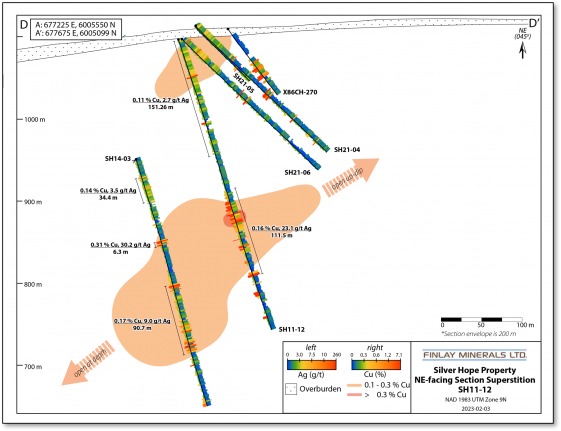Finlay’s 100%-owned Silver Hope property covers 21,691 hectares of ground surrounding the past-producing Equity Silver Mine in the prospective Skeena Arch region of central B.C.
The regional-scale northeast-trending Skeena Arch is a geologic uplift in the Stikine Terrane that hosts several mineral deposits of various types. The area surrounding the property hosts past-producing deposits including the Equity Silver and Silver Queen Au-Ag-Zn-Cu vein filling-replacement deposits and the Huckleberry, Bell – Granisle, and Endako porphyry deposits. Several companies, including Centerra Gold, Surge Copper, Equity Minerals, Sun Summit, Universal Copper, and Imperial Metals, are actively engaged in exploration in the region.
The most advanced targets on the property include the Main Trend and West Cu-Mo Porphyry. The Main Trend can be split into the Hope, Superstition and Gaul zones, which extends southward from the Equity Silver mine. The Main Trend hosts significant Cu and Ag mineralization in fractures, micro-fractures, veins, and massive sulphide sections. The West Cu-Mo Porphyry hosts significant Cu and Mo mineralization within quartz veins, massive chalcopyrite and molybdenite veins, and disseminated. Other mineral occurrences on the property include the Sam Zn-Ag bearing breccia, the East Trend (1 & 2), Zest, Equity East, Dina East, Allin, and Dina.
Finlay continues to drive expansion of the known mineralization within the Main Trend while developing other numerous exploration targets on the Silver Hope Property. The seven priority exploration areas are: Main Trend, West Cu-Mo Porphyry, East Trend 1, East Trend 2, Zest, Sam and Dina East.
The Silver Hope property is situated within the Skeena Arch, a regional-scale northeast-trending belt of sedimentary, volcanic, and associated plutonic rocks of the Stikine island-arc assemblage, which hosts several mineral deposits of various types in Central B.C. Silver Hope lies on the east margin of the southern Skeena Arch in an area of localized subsidence referred to as the Buck Creek Basin.
The Stikine Terrane was host to two main episodes of post-accretionary, continental margin arc magmatism: Upper Cretaceous (93 – 74 Ma) and Lower to Middle Eocene. Cretaceous intrusions in the region host the past-producing Huckleberry, Bell – Granisle, and Endako porphyry deposits.
In the Buck Creek Basin, two episodes of Paleogene volcanism are preserved: 1) Late Paleocene/ Lower Eocene Nanika Plutonic Suite; and 2) subvolcanic intrusions of the Goosly Lake Formation (52 Ma), which are believed to be responsible for the Equity Silver, Silver Queen Au-Ag-Zn-Cu, and Main Trend Cu-Ag-Au prospect (Silver Hope) vein filling-replacement deposits. The Equity Silver deposit is considered a replacement-style deposit and occurs directly adjacent to a monzodiorite stock of Goosly Lake Formation. At the Silver Queen deposit, ~30 km west of the property, Goosly intrusion-related dykes are contemporaneous with the emplacement of mesothermal and epithermal polymetallic veins.
The Silver Hope property is underlain predominantly by andesitic and basaltic volcanic rocks of the Eocene Endako Group surrounding an erosional window of uplifted Cretaceous Skeena Group stratigraphy which is bound to the west and northeast by stocks and plugs of Paleocene Nanika Suite and the Eocene Goosly Intrusive Suite, respectively.
Exposed Cretaceous Skeena Group stratigraphy strikes north‐northeast and dips moderately gently west. Younging from east to west, exposed Skeena Group consists of:
Surrounding the exposed Skeena Group stratigraphy, younger Cretaceous Kasalka Group andesite and Eocene Endako Group volcanics predominate.
At the western margin of the uplifted Cretaceous stratigraphic package, a quartz monzonite stock of the Paleocene Nanika Intrusive Suite extends for ~2 km along the strike of the sediments. This stock hosts the West Cu-Mo Porphyry mineralized prospect which was intersected in 2010 and 2011 drill holes.
The northeast edge of the Cretaceous stratigraphic package abuts an east-southeast trending complex of gabbro, monzogabbro, and monzonite of the Eocene Goosly Intrusive Suite. At the Main Equity Silver deposit, a plug of gabbro (48 Ma) with associated monzonite to diorite phases truncates pyroclastic flows of the Skeena Group, which hosts economic fracture-fill, disseminated, and replacement style mineralization. The margins of this intrusive complex were a target area for the 2020 and 2021 exploration programs.
Post-mineral andesite and quartz latite dykes of Eocene age (49 Ma) cut the Cretaceous and Eocene strata on both the Equity Silver and Silver Hope properties. Along the Main Trend (specifically the Gaul Zone), mineralization is often concentrated marginal to these late dykes, possibly due to remobilization or exploitation of long-lived structures, or concentration of strain and associated fluids along relatively competent tabular bodies.
The Silver Hope property hosts ten (10) known mineral occurrences and targets, including meso-thermal ‘Equity-Style’ Ag-Cu, polymetallic vein and replacement style Cu-Ag-Au+/-Pb+/-Zn and porphyry Cu-Mo mineralization. In addition to the advanced-stage Main Trend and West Cu-Mo Porphyry, several peripheral targets are being actively explored for porphyry, polymetallic vein, and replacement-style mineralization
The Main Trend extends southerly from the Equity Mine deposits and is a 2 km Cu-Ag-Au mineralized trend that encompasses, from north to south on the property: the Hope, Superstition and Gaul Zones. Mineralization comprises ubiquitous fracture-filling pyrite ± quartz, calcite, chlorite, chalcopyrite and tetrahedrite which locally form sub-metre zones of dense stockwork, micro fracturing and brecciation. Higher fracture density is associated with more intense alteration, brecciated veining, and greater diversity in sulphide minerals. The highest-grade Cu-Ag mineralization occurs in a series of parallel metre-scale zones of moderately to steeply west-dipping breccia veins and dense stockworks which host semi-massive tetrahedrite ± pyrite ± chalcopyrite, sphalerite and galena.
West Cu-Mo Porphyry
The West Horizon comprises Cu-Mo porphyry mineralization in a monzonite stock of the Paleocene Nanika Intrusive suite that traverses the western margin of the Skeena stratigraphic package. It is exposed at surface only as float and root jack. Drilling of the West Horizon in 2010 and 2011 yielded several long (~200 m) intercepts of ~0.3% Cu and 0.015 % Mo over a strike-length of ~ 1 km (Gruenwald, 2011).
Sam Occurrence
Another area for further exploration lies west of a deviation in the north end of the Cu-Mo porphyry Nanika stock, where two historic soil samples yielded up to 15.3 g/t Ag, 45 ppb Au, and 767 ppm Cu. At the Sam occurrence, ~2 km west, metre-scale massive sulphide veins and associated mineralization do not have a known intrusive source (BC Minfile 093L 260).
East Trend
The East Trend can be broken up into East Trend 1 and East Trend 2. The East Trend is underlain by dacitic tuffs, sedimentary rocks and possible volcanic flows that are thought to be prospective hosts for Cu‐Ag massive sulphide mineralization such as that seen at the former Equity Silver Mine. A prominent north-trending IP chargeability anomaly delineates the area and the presence of pyrite, arsenopyrite, tetrahedrite, galena, and sphalerite have been confirmed by rock sampling and drilling. East Trend 1 occurs along the footwall of a NNE trending ZTEM conductive axis while East Trend 2 is along another ZTEM conductive axis.
Zest
Favorable Skeena Group lithology that host the Equity and Main Trend mineralization were mapped and intersected in past drilling at the Zest target. Past drilling intersected 34.2 m assaying 2.92 g/t Au, 0.15% Cu and 3.9 g/t Ag in X87CH34 (BC Mineral Assessment Report 16770) and 6 m assaying 0.27 g/t Au, 0.47% Cu and 25 g/t Ag in X87CH278 (BC Mineral Assessment Report 15710). ALS GoldSpot has outlined the Zest target to potentially host Equity-style mineralization. A large east-west trending multi-element soil geochemical dispersion trail traces back to the Zest target based on glacial movement.
Equity East
Soil sampling identified a coincident multi-element geochemical anomaly trending east-west like the anomaly seen at Zest. ALS GoldSpot outlined the potential to host Equity-style mineralization at the Equity East target. Glacial movement traces the soil geochemical anomaly back to the area outlined by ALS GoldSpot. Rock samples collected included gabbro and tuffs, locally strongly oxidized with moderate to strong quartz, sericite and pyrite alteration. Minor quartz veining was present in some rock sampled with pyrite, galena and chalcopyrite. In 2021, ground-based IP surveys outlined a sizeable chargeability and resistivity anomaly over ~ 1 x 2 km, roughly coincident with the magnetic high. In 2022, three drill holes were completed in the Equity East Zone. All three holes intersected overlying Ootsa Volcanics followed by a Monzonite of the Goosly Intrusive Suite. SH22-01 intersected 0.81 m assaying 47.9 g/t Ag, 2.5% Pb and 4.5% Zn from 74.92 m. SH22-05 and 06 intersected minor galena and sphalerite veins within the Ootsa Volcanics.
Allin
The Allin occurrence is located 4.4 km east of Equity Main in an area underlain by andesites and trachyandesite flow breccias in the basal part of the Goosly Lake Volcanics. Mapping along Allin Creek shows the presence of a small body of quartz microdiorite and some highly altered gossanous volcanics that are probably dacitic. Several geochemical and geophysical surveys were conducted over the Allin claim area and outlined a multi-element soil geochemical anomaly over a large chargeability high and resistivity low. A few float samples were collected in an area that was logged in the past and were strongly mineralized with Cu and Ag. Drilling by Finlay and past operators have yet to find the source of those float samples.
Dina East
The Dina East is roughly 4 km east of the Dina showing. Dina East was recently identified by ALS GoldSpot as hosting overlapping porphyry and Equity-style mineralization potential.
Dina
The Dina occurrence, 350 m west of Goosly Lake, comprises pyrite, tetrahedrite and chalcopyrite disseminated in lapilli tuff and breccia as well as concentrated along steeply dipping bedding planes in argillite. A drillhole from 1970 intersected 0.22 % Cu and 20.23 g/t Ag in a sequence of dacite ash tuff and dust tuffs over 21.3 m from 39.6 to 60.9 m (Minfile 093L 313).
Goosly Lake
The Goosly Lake intrusion, 4.8 km east of Goosly Lake, is a quadrate body, approximately 3.2 km on a side, which cuts Early Mesozoic lavas and pyroclastic rocks with some argillite. The intrusion seems to be the source of trachyandesite and trachyte of the Eocene Goosly Lake volcanics.
Various geophysical methods have been successful in identifying targets on the Silver Hope property, which is largely covered by glacial till. Since 2007, Finlay has completed 8.8 km of Controlled-Source Audio-Frequency Magnetotellurics (“CSAMT”), 100 line-km of Induced Polarization (IP) surveys, 6 line-km of ground-based Gravity surveys, 467 km of airborne ZTEM surveys, and 1,585 km of Airborne Magnetic surveys. Successful IP campaigns have been completed over the Main Trend, West Cu-Mo Porphyry, and East Trend, as well as the Equity East and Allin targets in the central portion of the property. In 2013, a ZTEM survey was flown from the Main Trend and central portion to the southern edge of the property. In 2020, Finlay commissioned an Airborne Magnetic survey over nearly the entire property. The combination of these geophysical surveys with surface sampling and drilling have aided in targeting and increasing geological knowledge of the property.
The Main Trend manifests in IP surveys as a north-south trending, west-dipping high chargeability and lower resistivity anomaly present for > 2 km along the mineralized trend. The chargeability high coincides within the hanging wall of a high conductivity trend from the 2013 ZTEM survey, which connects northward to the Southern Tail and Main Zone of the former Equity Silver Mine. Measurements from oriented core show that the mineralized fractures, breccias and veins often follow a similar orientation as the geophysical anomalies.
The West Cu-Mo Porphyry is exposed at surface and a series of IP surveys has outlined a plug-like high chargeability feature with coincident low resistivity consistent with the intrusive host rock. The Cu-Mo mineralization is hosted in chalcopyrite and molybdenum which occurs disseminated and within veins throughout the intrusion.
The East Trend shows geophysical similarities to the Main Trend. The IP surveys have shown an east-dipping moderate chargeability and low resistivity anomaly. ZTEM imagery also reveals a conductive trend subparallel to that of the Main Trend along a portion of the East Trend. Past drilling at the East Horizon was down-dip of the chargeability and resistivity anomalies, potentially missing any mineralized horizon similar to that of the Main Trend.
In 2021, Finlay completed 21 line-km of IP in five survey lines over the central portion of the property; the survey successfully outlined two major high-chargeability anomalies occurring along the periphery of the magnetic high and beneath the multi-element soil geochemical anomalies underlying the Equity East and Allin target areas. A large magnetic high feature at surface above a ZTEM-derived low conductivity / high resistivity core at depth supports the presence of the Goosly Plutonic Suite beneath the central portion of the property. Several chargeability and resistivity IP anomalies occur at the periphery of the larger geophysical feature.
In 2024 , Finlay completed 8.8 km of CSAMT ground geophysical surveys and confirmed 4 targets. The CSAMT was successful in identifying the Superstition and Gaul Zones, within the Main Trend, and showing that the zones remain open at depth and to the southwest.
Superstition mineralization had a low resistivity anomaly where SH14-03 intersected 90.7 m assayed 0.17% Cu, 9.0 g/t Ag and 0.04 g/t Au from 310.3 m (BC Assessment Report Number 35888) and SH11-12 intersected 111.5 m assayed 0.16% Cu, 23.1 g/t Ag and 0.29 g/t Au from 204.0 m (BC Assessment Report Number 32622a & 32622b). This low resistive anomaly trends to the south to the Gaul Zone. The Gaul Zone was within a near vertical low resistivity anomaly where SH21-08 intersected 133.0 m assayed 0.30% Cu, 7.6 g/t Ag and 0.03 g/t Au from 32.0 m (BC Assessment Report Number 40283) and where SH20-04 intersected 62.2 m assayed 0.25% Cu, 11.6 g/t Ag and 0.06 g/t Au from 59.8 m (BC Assessment Report Number 39406).
The West Cu-Mo Porphyry was identified with a high resistivity and coincident magnetic low. The West Cu-Mo Porphyry had a high resistivity anomaly along L5400 and extends to the south for 650 m to L4750. Along L4750 and L4400 the high resistivity anomaly representing the West Cu-Mo Porphyry gets skewed and possibly extends to the west.
East Trend 1 was identified last year with a multi-element biogeochemical anomaly within a 600 x 800m with >100 ppm Cu soil geochemical anomaly. This low resistivity anomaly also correlates with a chargeability high and has yet to be drill tested.
The Main Trend, East Trend 1, East Trend 2 and West Cu-Mo Porphyry are part of a larger elliptical magnetic anomaly that includes the Sam Target. The Main Trend, East Trend 1 and East Trend 2 correspond to linear resistivity signatures and corresponding linear magnetic anomalies which wrap around a magnetic low and resistive high corresponding to the West Cu-Mo Porphyry which then wraps around a magnetic high. This target area could represent a large porphyry center which could be the cause for the mineralization in the area. Only a small portion of this target has been explored.
The Dina East target area was tested with two short CSAMT lines to follow up two targets generated by ALS GoldSpot and Finlay staff. L3300 and L4000 were designed to test a porphyry target and an overlapping polymetallic vein, a porphyry mineralization style target and a ZTEM conductivity trend. A steeply west dipping low resistivity feature was present on both lines corresponding to the overlapping polymetallic vein porphyry targets identified by ALS GoldSpot, and a conductive trend. This feature is similar to the low resistivity anomaly seen along the Gaul Zone and East Trend 1. Also, L4000 is another near vertical low resistivity anomaly along a ZTEM conductive trend identified as a porphyry target by ALS GoldSpot. Each line in Dina East had a deeper low resistivity anomaly wrapping around a high resistivity anomaly which correlates with a porphyry target as identified by ALS GoldSpot. These targets have had little to no known surface work and have recently been logged with easier access.
All the CSAMT sections maybe viewed here at: https://finlayminerals.com/site/assets/files/1927/july282024xsections.pdf
2020 Airborne Magnetics (TMI) Geophysical Survey of the Silver Hope
2020 Airborne Magnetics with 2021 IP Geophysical Survey Lines
All the cross-sectional IP lines may be viewed here:
2021 Line 5900N IP Resistivity and Chargeability Sections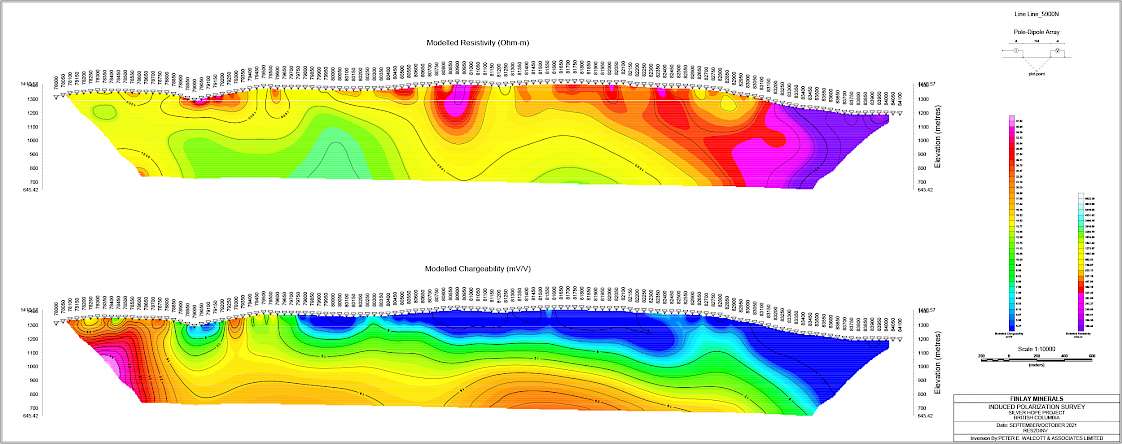
2021 Line 6900N IP Resistivity and Chargeability Sections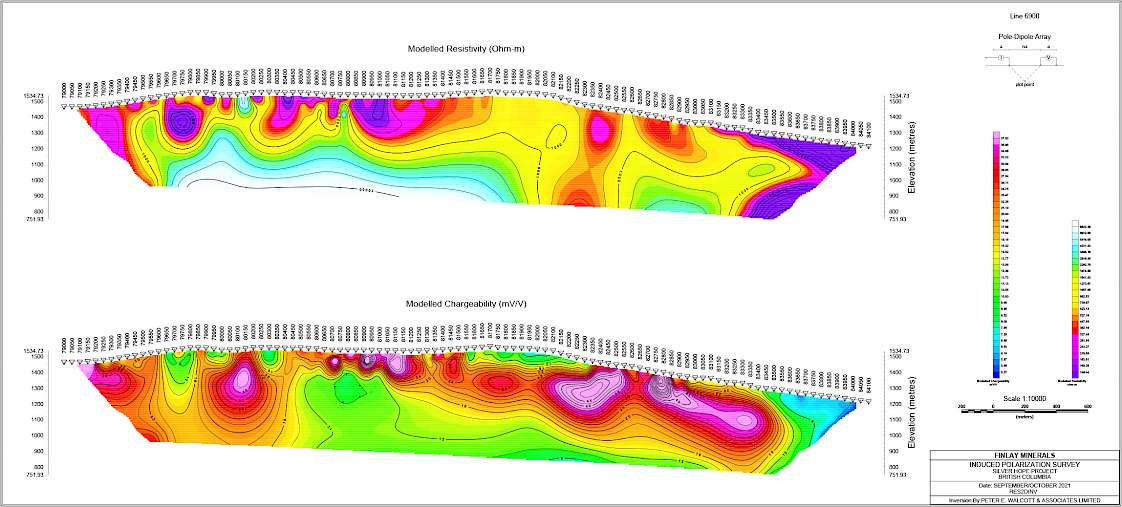
2021 Line 7400N IP Resistivity and Chargeability Sections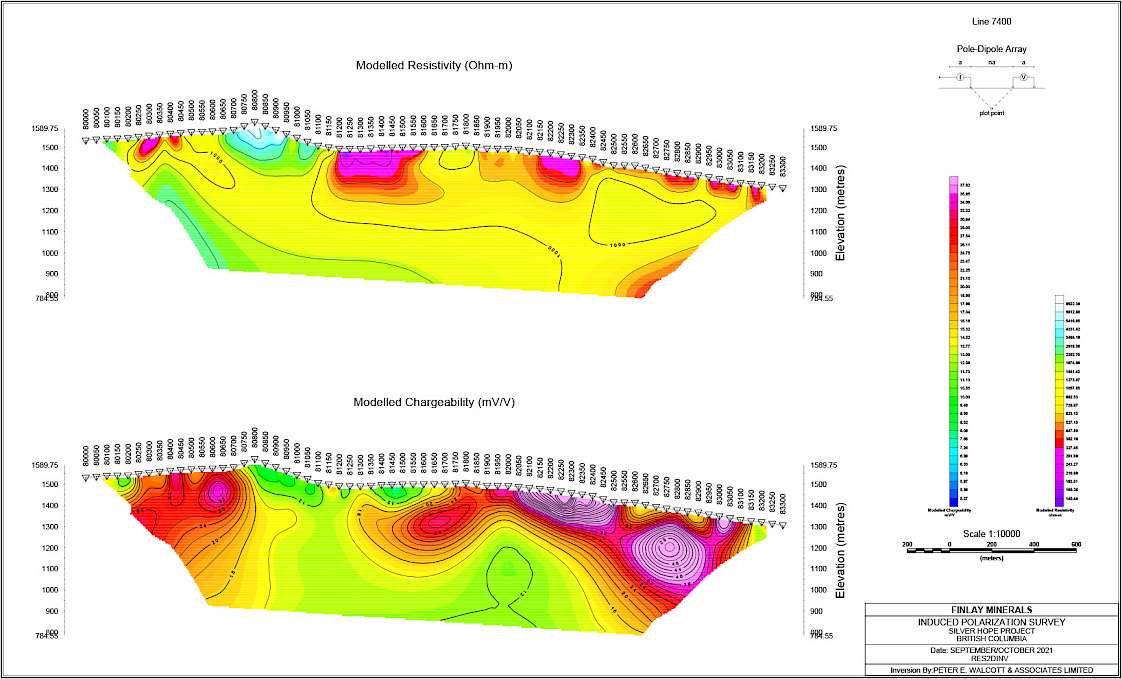
Since 2007, Finlay Minerals has drilled 14,341 m in 42 drill holes in the Main, West, and East Horizons. Previously, drilling had tested the Main Horizon, Allin Zone, Dina and the area east of the Sam showing. Most of the drilling completed by Finlay has targeted the low-sulphidation Cu-Ag ± Au mineralization along the Main Horizon south of the Equity Main Zone. Drilling has delineated the Hope, Superstition and Gaul Zones, which together comprise a west-dipping mineralized trend that extends for 2 km along strike.
Finlay has recently focused most of the drilling on the Gaul Zone which remains open at depth and to the south. The Gaul Zone coincides with a chargeability high and NNE-trending conductive trend. Finlay has completed 11 drill holes for 2,282 m within the Gaul Zone. Before 2007, drilling was completed at the Gaul Zone, but some drill hole assays are missing and note recorded in public documents. Mineralization at Gaul has been intersected over 500 m of strike and almost 200 m vertical depth.
Finlay has drilled 1,973 m in six drill holes within the Superstition Zone. The 2011 drill program intersected mineralization deeper than that of the Gaul and Hope Zones. Past drilling did not drill deep enough to test the west-dipping mineralized trend. Further drilling is needed to test the continuity of the mineralization along-strike towards Gaul and at depth.
The Hope Zone has been drill tested with 11 drill holes for 4,291 m. Mineralization is similar to the Gaul and Superstition Zones but the mineralization is hosted within narrower breccia zones and stockwork veins. Deeper drilling has intersected thicker higher-grade mineralization similar to the Gaul and Superstition Zones and requires further drill testing. Drilling has extended the mineralization over 250 m of strike and to a vertical depth of just over 400 m.
Between 2010 and 2011, Finlay drilled 9 drill holes for 3,773 m within the Cu+Mo+Au porphyry mineralization of the West Horizon. The drilling extended mineralization to 1 km along strike and to a vertical depth of 350 m. The West Horizon Cu+Mo+Au porphyry remains open to the west.
The 2022 drill program included three drill holes in Equity East and three drill holes in the Allin Zone for a total of 1,461 m. Drilling targeted IP and multi-element surface geochemical anomalies. Drilling identified propyltic to weakly altered Ootsa volcanics within the Allin Zone peripheral to a possible prophyry/higher temperature source. Drilling within the Equity East intersected Ootsa Volcanics overlying Monzonite of the Goosly Intrusive Suite. Further investigation is warranted based on anomalous assays and alteration.
Gaul Zone Assay Table
Superstition Zone Assay Table
Hope Zone Assay Table
West Horizon Zone Assay Table
Sam Zone Assay Table
2020 Airborne Magnetics Survey of the Silver Hope with Historic Drill Holes
Silver Hope Main Trend with Modelled Mineralization and Historic Drill Holes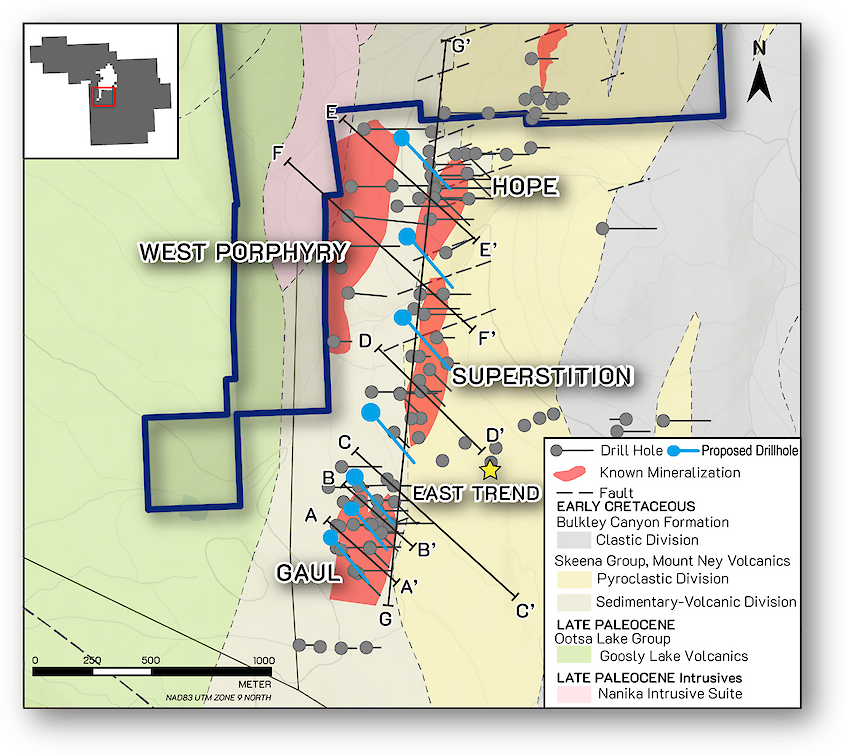
Main Trend Gaul Zone Section A-A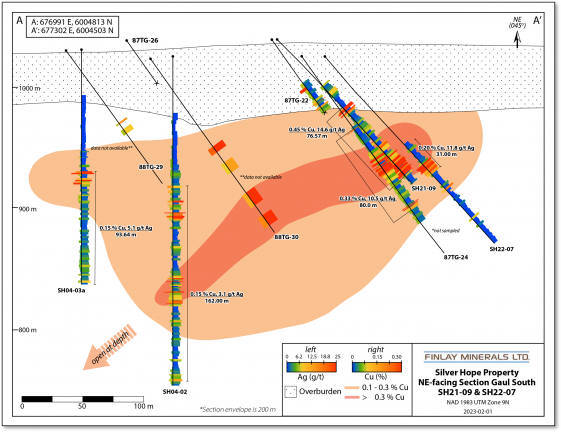
Main Trend Gaul Zone Section B-B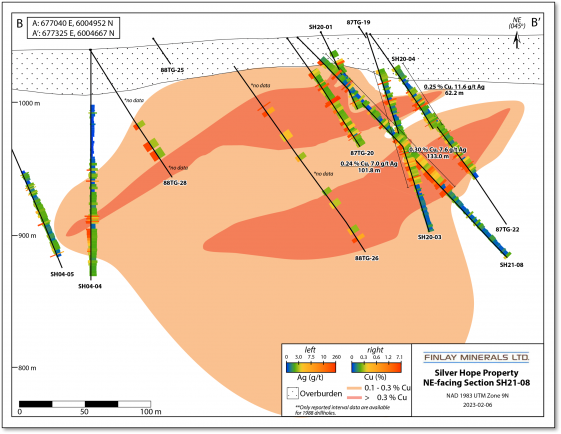
Main Trend Gaul Zone Section C-C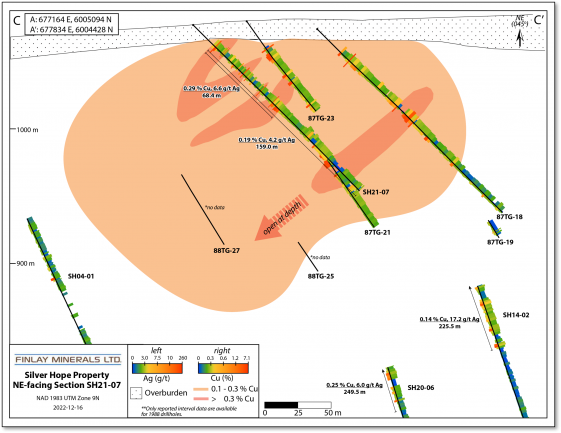
Main Trend Superstition Zone Section D-D